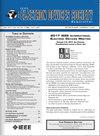Emergence of Negative Differential Resistance Through Hole Resonant Tunneling in GeSn/GeSiSn Double Barrier Structure
IF 2
3区 工程技术
Q3 ENGINEERING, ELECTRICAL & ELECTRONIC
引用次数: 0
Abstract
We examined the fabrication and the operation of GeSn/GeSiSn resonant tunneling diode (RTD) and demonstrated the observation of negative differential resistance (NDR) at a low temperature through the hole resonant tunneling. First, we revealed the possible designed contents of GeSiSn to Si and Sn of 40–60% and ∼10%, respectively to achieve the valence band offset over 0.3 eV with sustaining the biaxial strain value less than 1.0%, which is an important factor for the pseudomorphic growth of GeSn/GeSiSn heterostructure on Ge. Then, we successfully fabricated GeSn/GeSiSn RTD with a double barrier structure composed of ultra-thin GeSiSn barriers and GeSn well, which has the steep heterointerface. The current-density–voltage (J–V) characteristics at 10 K of the fabricated GeSn/GeSiSn RTD showed NDRs at applied voltages of approximately −1.5 and −1.8 V with peak to valley current ratio of 1.06 and 1.14, respectively, and peak current density of ∼3 and ∼5 kA/cm2, respectively. We also demonstrated that the observed NDR is reproducible. The quantum level and J–V simulations suggests that these two NDRs would originate from the hole resonant tunneling current through the first and second quantum levels formed in the GeSn well layer. Furthermore, we also discussed issues newly found in this study and future remarks of GeSn/GeSiSn heterostructures as RTD applications for the terahertz oscillator and the nonvolatile RAM.GeSn/GeSiSn双势垒结构空穴共振隧道负差分电阻的产生
研究了GeSn/GeSiSn谐振隧道二极管(RTD)的制备和工作原理,并展示了通过空穴谐振隧道在低温下观察到的负差分电阻(NDR)。首先,我们揭示了GeSiSn对Si和Sn的可能设计含量分别为40-60%和~ 10%,以实现超过0.3 eV的价带偏移,同时维持双轴应变值小于1.0%,这是GeSn/GeSiSn异质结构在Ge上伪晶生长的重要因素。然后,我们成功地制备了具有陡峭异质界面的由超薄GeSiSn势垒和GeSn井组成的双势垒结构的GeSn/GeSiSn RTD。制备的GeSn/GeSiSn RTD在10 K时的电流-密度-电压(J-V)特性表明,施加电压约为- 1.5和- 1.8 V时,ndr分别为1.06和1.14,峰谷电流比分别为~ 3和~ 5 kA/cm2。我们还证明了观察到的NDR是可重复的。量子水平和J-V模拟表明,这两种ndr可能是由在GeSn阱层中形成的通过第一和第二量子水平的空穴共振隧穿电流产生的。此外,我们还讨论了本研究中新发现的问题,以及GeSn/GeSiSn异质结构在太赫兹振荡器和非易失性RAM中作为RTD应用的未来展望。
本文章由计算机程序翻译,如有差异,请以英文原文为准。
求助全文
约1分钟内获得全文
求助全文
来源期刊

IEEE Journal of the Electron Devices Society
Biochemistry, Genetics and Molecular Biology-Biotechnology
CiteScore
5.20
自引率
4.30%
发文量
124
审稿时长
9 weeks
期刊介绍:
The IEEE Journal of the Electron Devices Society (J-EDS) is an open-access, fully electronic scientific journal publishing papers ranging from fundamental to applied research that are scientifically rigorous and relevant to electron devices. The J-EDS publishes original and significant contributions relating to the theory, modelling, design, performance, and reliability of electron and ion integrated circuit devices and interconnects, involving insulators, metals, organic materials, micro-plasmas, semiconductors, quantum-effect structures, vacuum devices, and emerging materials with applications in bioelectronics, biomedical electronics, computation, communications, displays, microelectromechanics, imaging, micro-actuators, nanodevices, optoelectronics, photovoltaics, power IC''s, and micro-sensors. Tutorial and review papers on these subjects are, also, published. And, occasionally special issues with a collection of papers on particular areas in more depth and breadth are, also, published. J-EDS publishes all papers that are judged to be technically valid and original.
 求助内容:
求助内容: 应助结果提醒方式:
应助结果提醒方式:


